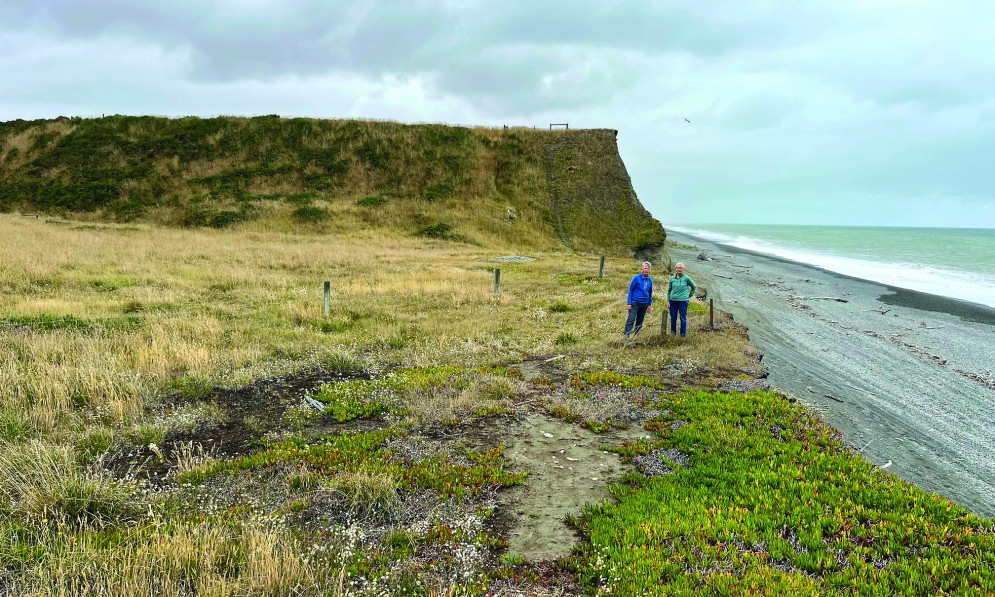Forest & Bird’s Ashburton Branch worked with scientists and landowners for more than a decade to save a new species of Canterbury daisy. By Mary Ralston
Forest & Bird magazine
A version of this story was first published in the Autumn 2023 issue of Forest & Bird magazine.
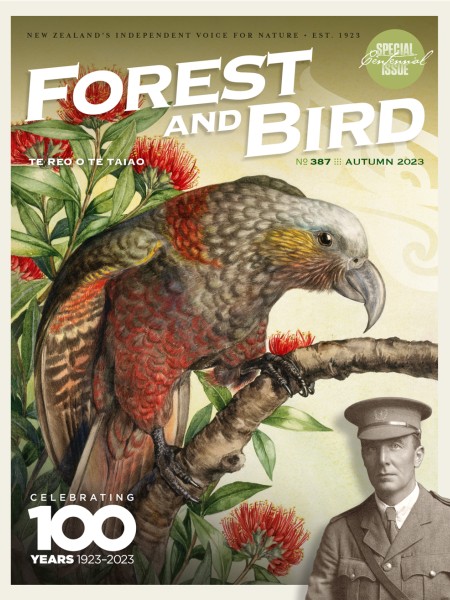
Two wire cages face the Pacific Ocean at Wakanui, coastal Canterbury. Inside are the last naturally occurring individuals of a small endemic daisy known locally as the Wakanui Craspedia.
There is no hope for these two plants. They will not produce any offspring, and in any case their growing site is doomed by the crumbling coastline.
Luckily, this isn’t the end of the road for the species, thanks to a small group of conservationists, scientists, and landowners who were determined to save it from extinction.
They managed to propagate the plant so it could be safely translocated to four new locations, where it is safely growing today.
And, in an exciting development last year, the Wakanui Craspedia was confirmed to be a new species and given the name Craspedia diversicolor.
"At one point, the
Wakanui Craspedia
was possibly the rarest
plant in Aotearoa."
The rosette-forming perennial daisy, also known as puatea or woollyhead, is one of the fragments of native biodiversity of the Canterbury Plains.
In the 1960s, the species was known from four sites on the Canterbury Plains, including a healthy population at Wakanui, east of Ashburton.
Scientists recently described the Wakanui plants as a new species Craspedia diversicolor. Image Rainer Vogt
It was probably once widespread in open habitat, but it couldn’t compete against cultivation, vigorous introduced grasses, grazing mammals, and fire.
Over the following decades, the plants at the other sites disappeared, leaving just the ones at Wakanui.
In 2001, plant systematists Dr Ilse Breitwieser and Kerry Ford of Manaaki Whenua – Landcare Research, in Lincoln, visited the Wakanui site and counted 30 plants.
Numbers fluctuated over the next 10 years, but the trend was going the wrong way. Things were looking bleak for this little daisy.
In 2011, Ashburton Forest & Bird members Val Clemens and Edith Smith were alerted to the dire situation by QEII botanist Alice Shanks.
They began monitoring the Wakanui plants, walking along the beach and clambering up the bank to the site.
“When we first got involved, there were only four plants. Two that were closer to the sea disappeared one winter, leaving just two higher up the slope,” says Val.
“At that point, it may have been New Zealand’s most endangered plant species.”
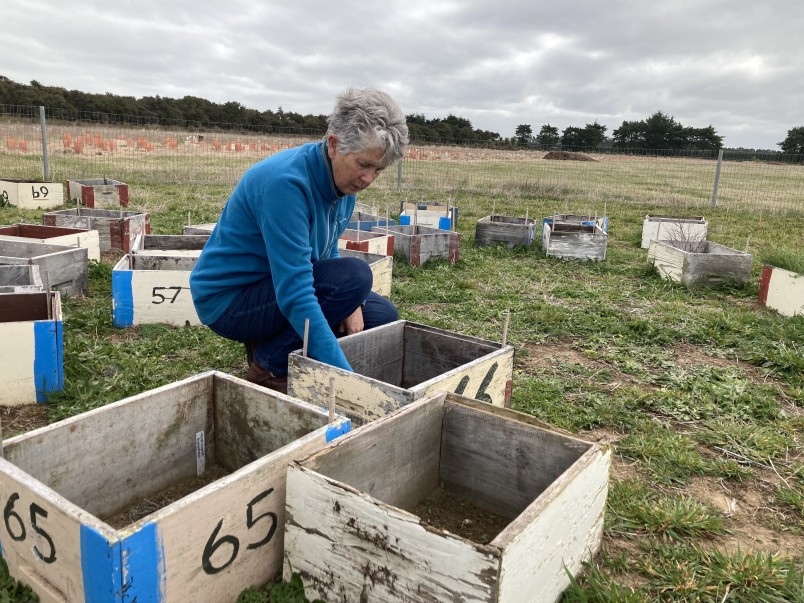
Val Clemens planting out seedlings in a local reserve. Image supplied
The crisis was recognised and a rescue mission began. The landowner built cages to protect the plants from grazing. Seed was collected from the two remaining specimens, but it wasn’t viable.
The plants may flower at different times, and the tiny hoverflies that pollinate the flowers may struggle with the conditions.
It’s a fairly extreme site that is usually windy, often salty, hot and dry in summer, and cold and bleak in winter.
The surrounding native vegetation – flax, tussocks, matagouri, coprosomas, and other shrubs – that would have buffered the Craspedia and provided habitat for insects is no longer there.
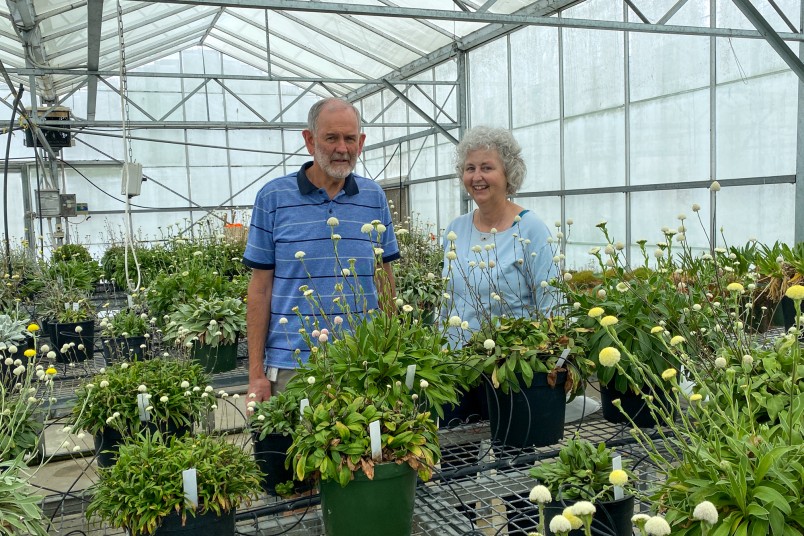
Ilse & David Purcell in greenhouse Lincoln. Image Kim Triegaardt
Fortunately, Ilse and Kerry had collected a plant in 2001 and grown it at Manaaki Whenua’s experimental nursery at Lincoln, south of Christchurch.
In 2020, pollen was collected from the Wakanui specimens and taken to Lincoln for crossing, and vice versa. This was a mission in itself – pollen is only viable for a few hours, so there was an urgency to the drive from Lincoln and walk along the beach.
But it worked – seed was produced, and Manaaki Whenua nurseryman David Purcell raised 80 seedlings in the greenhouse.
In 2021, some of the seedlings were planted at a scientific reserve managed by the Ashburton Forest & Bird Branch, and others at a private reserve, Christchurch Botanic Gardens, and Manaaki Whenua’s Lincoln site.
“The good thing is that, if you can get them to cross, they may produce hundreds of seeds,” says Ilse.
Now there are more than 50 plants at four sites, as well as the original two, so the immediate crisis has been averted.
But it’s still a very small population, and there’s a risk the species is vulnerable because of the loss of genetic variation.
There’s also the risk of losing remaining individuals through fire, grass grub, or inadequate site conditions.
The situation is a bit like an intensive care unit – the plants need active management: they need to be weeded, protected from the elements, and watered when it’s dry.
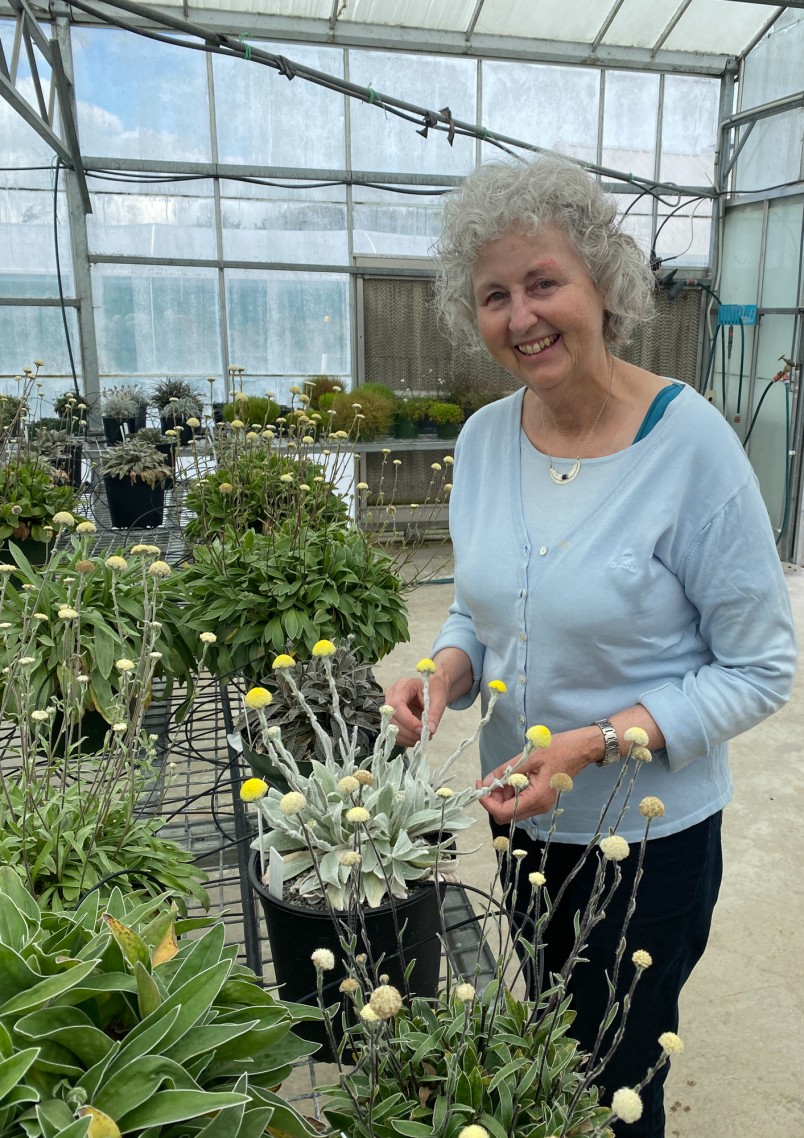
Dr Ilse Breitwieser with Craspedia plants at Manaaki Whenua’s experimental nursery, Lincoln. Image Kim Triegaardt
The struggle to save a species has been won for now, but the habitat and the ecosystem it belonged to have been lost. Managed reserves are the best we can do.
“The continued commitment and expertise of Val and Edith has been amazing,” adds Ilse.
“We wouldn’t have saved the species without them. It’s been a great collaboration between volunteers, the scientific and conservation management communities, and landowners.”
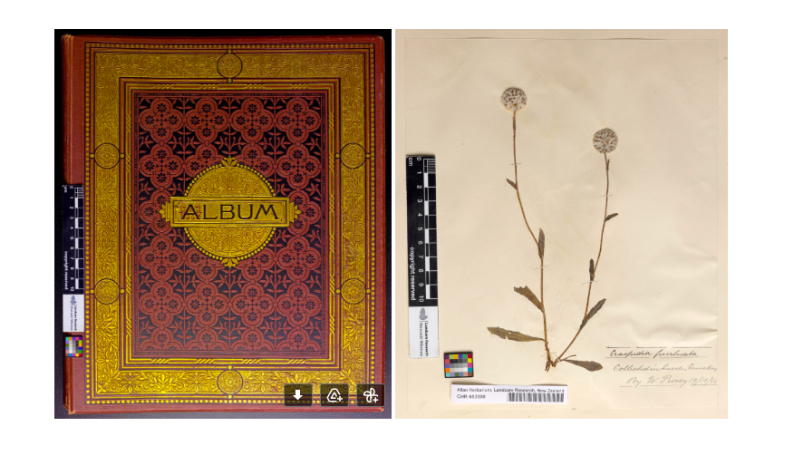
The Piercy specimen was contained in an album presented to his wife in 1884. Image Forest & Bird
Historic herbarium specimens suggest Craspedia diversicolor was once a common dryland species. A beautiful album of pressed flowers given by William Piercy to his wife in 1884 contains a Craspedia with dark red-purple anthers that he collected from Lincoln cemetery. Another specimen collected near Ashburton in 1918 also has the same coloured anthers and the leaf characteristics of Craspedia diversicolor. It was found close to one of the reserves where its propagated modern-day cousins are growing today, more than 100 years later.
Daisy discoveries
There are 11 known species of Craspedia in New Zealand, and it is thought there could be another 50 that are not yet named. Ilse Breitwieser and Kerry Ford recently described four new species with distinctive dark red-purple anthers, including Craspedia diversicolor. All four are threatened and only found at single locations – Wakanui, Lake Heron, Kaitorete Spit, and Pisa Flats. Breitwieser and collaborators are reviewing the Craspedia genus.
They have grown more than 500 plants from all over New Zealand in a greenhouse to see whether morphological charateristics such as leaf colour, hair cover, and shape are genetically determined or influenced by environmental factors.
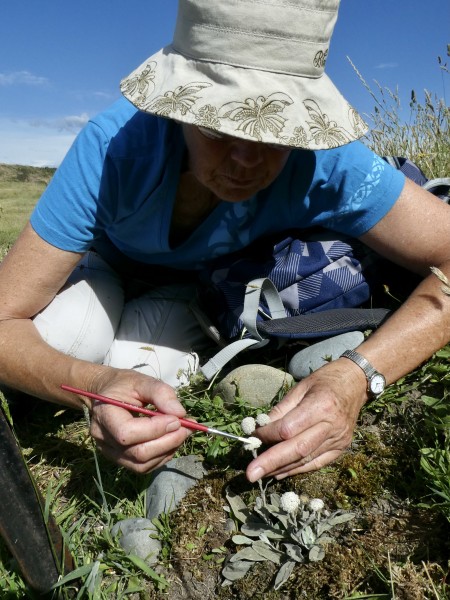
Val pollinating Craspedia. Image Edith Smith
“One of the key distinguishing characters of the Wakanui species is observable differences in leaf colour. That’s why we called it ‘diversicolor’,” says Ilse.
Research by Ford and collaborators suggests Craspedia arrived from Australia, on the wind or carried by a bird, three million years ago.
“This was quite a major finding,” adds Ilse. “It means our research could concentrate on the species in New Zealand, knowing they don’t also occur in Australia.”

